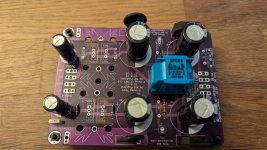I'll tell you what... My ad1862 with tube stage has nothing to envy (nothing less) than a 10,000€ DAC, no jokes.I'll check those out. Grunf has a good reputation in my mind. The name lampizr rings a bell but I can't say I specifically remember anything about it or him. I do know that I consider myself an audiophile but a rational audio file. $10,000 for a DAC? That just borders on insane. Talk about ridiculous cost of diminishing returns. I'll bet it's a good DAC, but is it worth that kind of money? I seriously seriously doubt it. That kind of stuff is for people that have more money than brains.
Would like to have a look at this Loesch tda1541a DAC.For TDA1541A, I just will go with the CD-77 tube stage @ThorstenL (aka M. T Loesh) had the kindness to publish in the log TDA1541A thread. Of course that certainly means more effort to source good tubes and also in the layout (@Michelag : resistors nearer of the tubes pins as already inputed 😉 ; change those wiresat the bottom by the resistors the way I said in a post above to avoid osci).
Of course CCS (Grunf) or Mu follower has interest as well. But first source the good tube (NOS) and match the ones that have too much difference between the two triodes... (russian ones have a lot of difference between the two internal triodes for illustration, but not only D3A(single triode) that are osci beast have a lot of difference between two tubes, you need matching effort which can become expenssive for the ones not havinng great stock... and don't let talk about chineese tubes (save your monney please with that alixpresse kits and bad layouts pcbs)
For layout, sorry, I didn't understand your point.
Regarding triode matching, yes, it's true, but that's part of the hobby, and 8 out of 10 NOS 6n23p I experienced gave me no problems.
It all depends what's your target, and how much money and time are you willing to put in the project. Applies everywhere. Just like diminishing returns.
A good aussie friend of mine which is tubes expert said to me you better put the resistors close to the tubes pins with very few 2 mm lead length max on the tube side (to be sure) to avoid osci.
I told you already in a post above. You have not to change the pcb, just swapp that wires of your pic with the resistors the way I describe to avoid osci risks.
Please don't go with 6N23P but the EV series <1980s' that are very less noiser than the non EV that are poor copycat of ECC88. Unfornatully the mismatch between the two triodes is even worse than ECC88/6DJ8 (6922, well at your risk it is industrial tube so-so for hifi). If you have luck as I : tookk E188CC ! Or 5687 à l T Loesch.
tip : A member prefered ad811 to tubes with te ad1862. Tubes are better for tda1541A cause 0 - 4 mA, perfect for a grid input 🙂. I have said this eleven time in this thread. I should be Cassender !
I told you already in a post above. You have not to change the pcb, just swapp that wires of your pic with the resistors the way I describe to avoid osci risks.
Please don't go with 6N23P but the EV series <1980s' that are very less noiser than the non EV that are poor copycat of ECC88. Unfornatully the mismatch between the two triodes is even worse than ECC88/6DJ8 (6922, well at your risk it is industrial tube so-so for hifi). If you have luck as I : tookk E188CC ! Or 5687 à l T Loesch.
tip : A member prefered ad811 to tubes with te ad1862. Tubes are better for tda1541A cause 0 - 4 mA, perfect for a grid input 🙂. I have said this eleven time in this thread. I should be Cassender !
Last edited:
Hey there, to whom are you speaking 😉
Voskhod 'for export' mid 1970s 6n23p-ev tubes, single wire, NOS and clean Ni plated pins here.
"Osci" not available here.
These beat the s**t out of Siemens E188CC, Telefunken CCa, Amperex and $$$$$ friends.
And of course I've got my self built tube tester.
Voskhod 'for export' mid 1970s 6n23p-ev tubes, single wire, NOS and clean Ni plated pins here.
"Osci" not available here.
These beat the s**t out of Siemens E188CC, Telefunken CCa, Amperex and $$$$$ friends.
And of course I've got my self built tube tester.
D3A(single triode) that are osci beast have a lot of difference between two tubes, you need matching effort
Not sure i agree at all. Have used D3A many times and even more the E280F which i prefer. Not once had an issue with oscillation. Or matching. Certainly not more than with any other tube.
Using tubes in a dac is something i don't understand philosophically. At very best transformers and tubes are sound manipulating devices, often imposing a strong personality upon the sound. Having spent most of the last 40 years using both i am certainly not averse to strong sonic flavours. Yes, i also enjoy Indian and Thai 🙂
But why in a source component? Do we have to add strong spices right at the source? Can we not wait for the preamp or power amp?
The full cocktail of magnetic saturation and hysteresis together with tube microphony?
Is the digital sound that terrible that we cannot bear the truth at all?
I am flabbergasted that audiophiles equate the Lampizator half baked tube nonsense with SOA MSB dacs.
Is this the era of post truth in audio? 😛
Okay, I meant : buy two D3A you are very not sure they are appaired enough. Buy an E188CC and the two triodes are matched within 5% from factory and relative not much microphonics. Just an illustration.
I know I have to make the jump with a modern chip and a better discrete stage with not the problems tube or op amps have for that task... but this is nostalgia and simple fun!
I have also TDA1540s... is it usefull, not really, but so fun to make them work and listen to the differences.
Many members adverted (me) the good modern designs are hard to beat. And I hear you about your ESS9018 Dac if I remember or JosephK with AK4999 iirc. But voilà, the front end were not so good imho for those speedier frequency... Things have changed indeed and diyers have now access to better front ends. Although those dacs needs more parts, it is more expensive and pcbs are harder to design.
I do believe we should all have a multichannels dac able of filtering the drivers of our loudspeakers to make them active.... But with eas GUI like MiniDSP
It is hard to believe all sources could be the same though. Change a little thing and two dacs sounds different. Even with the modern ones : they sound different from each others.
It is possible we want to add flavors or give up some clarity or too much precision to hide bad reccordings I often wondered...
At the end I am still amazed how an ad1862 or a TDA1541A can sound good with a little care and less fast front end. It is more easy for average diyers like I am and many areas well. And I was said some MSB were not sounding so good (But I do not know, never heard one).
Tubes design indeed can cost rapidly but they can be very linear, no ? Good enough for a 16 bits dac and old 16/44 materials, perhaps (with some nice flavor à la 300B with its regular harmonics decay ?!) ; yes certainly a taste flavor preference. I really enjoyerd woodturner-fran listening tests between all the I/V but not only of course. I think it makes sense because we can read the fun behind all these experiments. Same thing motive surely the OP of the thread I surmise too.
You can really make a little good and simple DAC that sound good with few things. OK tubes are not the simpliest way.
Sorry I digress.
I know I have to make the jump with a modern chip and a better discrete stage with not the problems tube or op amps have for that task... but this is nostalgia and simple fun!
I have also TDA1540s... is it usefull, not really, but so fun to make them work and listen to the differences.
Many members adverted (me) the good modern designs are hard to beat. And I hear you about your ESS9018 Dac if I remember or JosephK with AK4999 iirc. But voilà, the front end were not so good imho for those speedier frequency... Things have changed indeed and diyers have now access to better front ends. Although those dacs needs more parts, it is more expensive and pcbs are harder to design.
I do believe we should all have a multichannels dac able of filtering the drivers of our loudspeakers to make them active.... But with eas GUI like MiniDSP
It is hard to believe all sources could be the same though. Change a little thing and two dacs sounds different. Even with the modern ones : they sound different from each others.
It is possible we want to add flavors or give up some clarity or too much precision to hide bad reccordings I often wondered...
At the end I am still amazed how an ad1862 or a TDA1541A can sound good with a little care and less fast front end. It is more easy for average diyers like I am and many areas well. And I was said some MSB were not sounding so good (But I do not know, never heard one).
Tubes design indeed can cost rapidly but they can be very linear, no ? Good enough for a 16 bits dac and old 16/44 materials, perhaps (with some nice flavor à la 300B with its regular harmonics decay ?!) ; yes certainly a taste flavor preference. I really enjoyerd woodturner-fran listening tests between all the I/V but not only of course. I think it makes sense because we can read the fun behind all these experiments. Same thing motive surely the OP of the thread I surmise too.
You can really make a little good and simple DAC that sound good with few things. OK tubes are not the simpliest way.
Sorry I digress.
We agree about practically everything. The E188CC is a premium tube, sold at a premium price. The e280F that i like used to be a pedestrian tube at a pedestrian price, so you'd better buy a dozen. I see this no longer is the case, it is now the new C3g 🙂.
The 1862 took some work until it fitted but now i am quite happy with what it does. Which is a first for me with NOS. 811 as i/v atm, Mundorf electrolytic caps in the analogue PS replaced with Nichicon Gold Tune together with some obscure Ge diodes. And voila there are highs and lows, all at the same time and voices and violins aren't screwed either. 🙂
The 1862 took some work until it fitted but now i am quite happy with what it does. Which is a first for me with NOS. 811 as i/v atm, Mundorf electrolytic caps in the analogue PS replaced with Nichicon Gold Tune together with some obscure Ge diodes. And voila there are highs and lows, all at the same time and voices and violins aren't screwed either. 🙂
I have to try the ad811 and LME49713 ha (rocelec). But fews things worry me there: the 1k to 500R input...can maybe swapped by feritebead or tined smd coil as Abrax inputed) , the non linear and thermal noise behavior of the ic itself due to heat. At the end the opa861 has only 7R iirc...
But I smell coming discrete CF perhaps.
Problem as always with discrete is to try to avoid matching w/o the quality is lowered because of that. Personal choice of course.
I had the chance to have an 1970 Herleen E188CC at pédestrian price, ahaha .
But I smell coming discrete CF perhaps.
Problem as always with discrete is to try to avoid matching w/o the quality is lowered because of that. Personal choice of course.
I had the chance to have an 1970 Herleen E188CC at pédestrian price, ahaha .
I've read the opposite story quite offen: the power amp as neutral as can be and use pre or source to spice up things to your liking.But why in a source component? Do we have to add strong spices right at the source? Can we not wait for the preamp or power amp?
You probably saying that if you play around this early in the reproduction of music, you end up with too much altered outcome.
To me OPAs (with feedback) are worse than tubes. Not all created the same way, so using AD815 (pre) sounded very different and also OPA861 (from my AYA) is also another story. I'm curious if a buffer (tube or SS) will be a better choice.
And there is also AD811, thanks to Grunf
You probably saying that if you play around this early in the reproduction of music, you end up with too much altered outcome.
Exactly. Spicing up the source pushes you to use weird sounding components downstream to counterbalance. True for analogue as well - some high end tonearms use intolerably colourful sounding wire, perhaps to make them stand apart sonically, but i see it as a serious problem.
Tube microphony is my biggest objection at low signal levels. The higher the voltage, the less detrimental it becomes.
for +/-5V? 4.7k according to the schematic. You dont even need that for the regulator to function. It is for the LED.
I didnt build this PSU. But it is shown in here:

I didnt build this PSU. But it is shown in here:
For those wanting AD1865R adapters, they are all ready to ship this week with decoupling caps. @Ryssen & @Michelag I'll be testing your chips and adapters before sending, I have to listen to something, you guys took all my DAC chips 😉
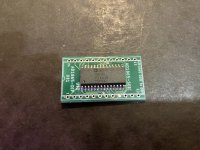
Somewhere in this pic is an endgame DAC...
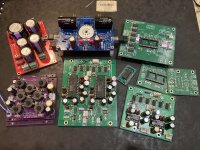
Mike's revised tube I/V stage by grunf
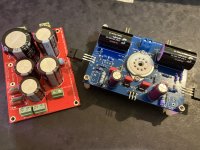
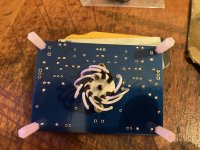

Somewhere in this pic is an endgame DAC...

Mike's revised tube I/V stage by grunf


What's the thing from Richard Rich?
You mean the Dark iv? Got another one when I returned yours 😉
People have spoken about upgrading the heatsink on the JLSounds board.

I am guessing that a small stamped type such as this one, is going to be not much of an upgrade if any?

Can anybody offer any recommendations or advice?
I am guessing that a small stamped type such as this one, is going to be not much of an upgrade if any?
Can anybody offer any recommendations or advice?
- Home
- Source & Line
- Digital Line Level
- DAC AD1862: Almost THT, I2S input, NOS, R-2R
